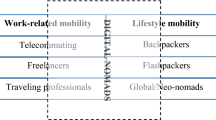Abstract
Using time-use data from Canada, Norway, and Sweden, this study briefly outlines the essence of the activity setting approach and illustrates one aspect of its usefulness by exploring the impact of social contact on travel behaviour. The activity system approach views behaviour in context. Activity settings are generic components of the activity system and studying them using time-use diaries can provide major insights into travel behaviour. Focusing on social contact, this paper characterizes the social environment in terms of social circle (interaction partners) and social space (location). The analysis shows that there are clear differences in the levels of social interaction across various groups, including those who work at home. The 1992 Canadian data showed people working at the workplace spend relatively more time with others, about 50% of total time awake. Working at home reduced the time with others to a low of 15.7%. when people worked at home the family benefited, almost doubling the time spent with them compared to those working at the workplace. Persons working at home only spend the most time alone. There is a tendency for persons with low social interaction to travel more. It is argued that individual need, or want, social contact and if they cannot find it at the workplace they will seek it elsewhere thus generating travel. Whether this is the result of need or opportunity is of minor relevance, what it does suggest is that working in isolation at home will not necessarily diminish travel but rather may simply change its purpose.
Similar content being viewed by others
References
Chapin FS, Jr. (1974) Human Activity Patterns in the City: What Do People Do in Time and Space. Toronto: John Wiley.
Cullen I & Godson V (1975) Urban networks: The structure of activity patterns. Progress in Planning 4: 1-96. Pergamon Press.
Davies R (1995) Telecommunting, social roles and managing telecommuters. Telecommunting and Employee Effectiveness, April-October, 1995. Internet Conference, MCB Press.
Fischer CS (1977) Networks and Places: Social Relations in the Urban Setting. New York: Free Press.
Grrnmo S (1982) Use of time and quality of Life: dimensions of welfare related to specific activities. In: Staikov Z (ed) It's About Time, pp. 97-117. Institute of Sociology at the Bulgarian Academy of Sciences and Bulgarian Sociological Association.
Hamer P, Kroes E & Van Oostroom H (1991) Teleworking in the Netherlands: An evaluation of changes in travel behaviour. Transportation 18: 365-382.
Hagerstrand T (1970) What about people in Regional Science? Paper and Proceedings of the Regional Science Association, 24.
Handy SL & Mokhtarian PL (1996) Forecasting telecommuting. Transportation 23: 163-190.
Harvey AS (1982) Role and context: Shapers of behaviour. Studies of Broadcasting 18: 70-92.
Harvey A (1997) From activities to activity settings. In: Ettema D & Timmermans H (co-eds)Activity Based Approaches to Travel Analysis. Tarrytown, New York: Pergamon Press.
Harvey AS, Elliott DH & Procos D (1977) Sub-populations Relevant to the Study of the Use of Time. A working paper, Institute of Public Affairs, Dalhousie University, Halifax.
Janelle DG & Goodchild M (1983) Diurnal patterns of social group distributions in a Canadian city. Economic Geography= 59(4): 403-405.
Jones PM (1979) New approaches to understanding travel behavior: The human activity approach. In: Hensher D & Stopher P (eds) Behavioral Travel Modelling, pp. 55-80. London: Croom-Helm.
Jones PM (1983) Understanding Travel Behaviour. Great Britain: Antony Rowe Limited.
Kitamura R & Nilles JM (1990) Telcommuting as a transportation planning measure: Initial results of California pilot project. Transportation and Research Record 128: 98-104.
Kutter E (1973) A model for individual travel behaviour. Urban Studies 10(2): 235-258.
Lewin K (1951) Field Theory in Social Science. New York: Harper & Row.
Lynch K (1972) What Time is This Place? Cambridge: Mass., MIT Press.
Maslow A (1954) Motivation and Personality. New York: Harper & Row.
Michelson W (1996) Sampling through episodes: Telecommuting. The Use and Value of Time: New Directions in Data Collection and Analysis, September 2-4, 1996, Vienna
Mokhtarian PL (1996) The information highway: Just because we're on it doesn't mean we know where we're going. World Transport Policy and Practice 2(1/2): 24-28.
Pas EI (1984) The effect of selected socio-demographic characteristics on daily travel-activity behaviour. Environment and Planning 16: 571-581.
Pas E (1988) Weekly travel activity behavior. Transportation (15): 89-109.
Pas E & Harvey AS (1997) Time-use research and travel demand analysis and modelling. In: Ryuichi K & Lee-Gosselin M (eds) Understanding Travel Behavior in an Era of Change. New York: Pergamon Press.
Robinson JP, Kitamura R & Golob TF (1992) Daily Travel in The Netherlands and California: A Time Diary Perspective. The Hague: Hague Consulting Group.
Schneider A (1972) Patterns of social interaction. In: Szalai A (ed) The Use of Time. The Hague: Mouron.
Scheuch EK (1972) The time budget interview. In: Szalai A (ed) The Use of Time. The Hague: Mouton.
Virtual}.
Szalai A (1972) The Use of Time. The Hague: Mouton.
Aas D (1982) Design for large scale, time-use studies of the 24-hour day. In: Staikov Z (ed) Its About Time. Sofia: Institute of Sociology at the Bulgarian Academy of Sciences and the Bulgarian Sociological Association.
Author information
Authors and Affiliations
Rights and permissions
About this article
Cite this article
Harvey, A.S., Taylor, M.E. Activity settings and travel behaviour: A social contact perspective. Transportation 27, 53–73 (2000). https://doi.org/10.1023/A:1005207320044
Issue Date:
DOI: https://doi.org/10.1023/A:1005207320044




